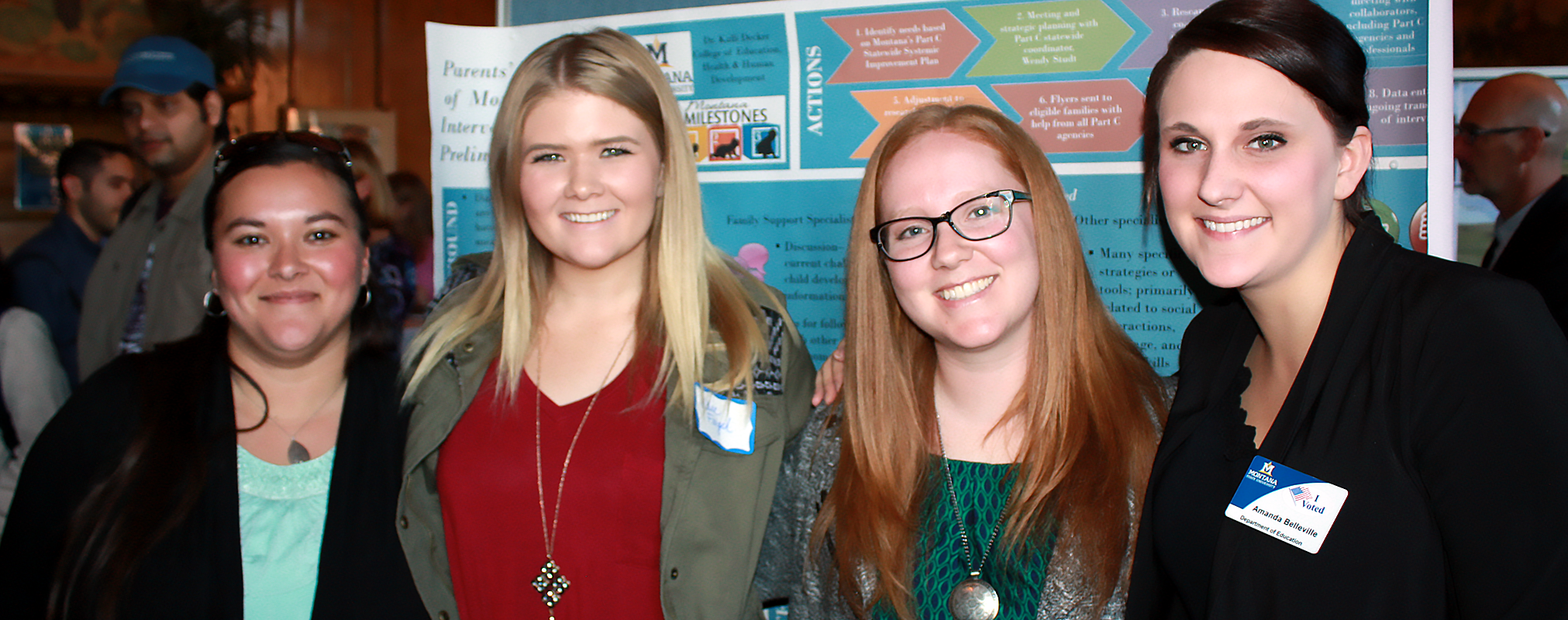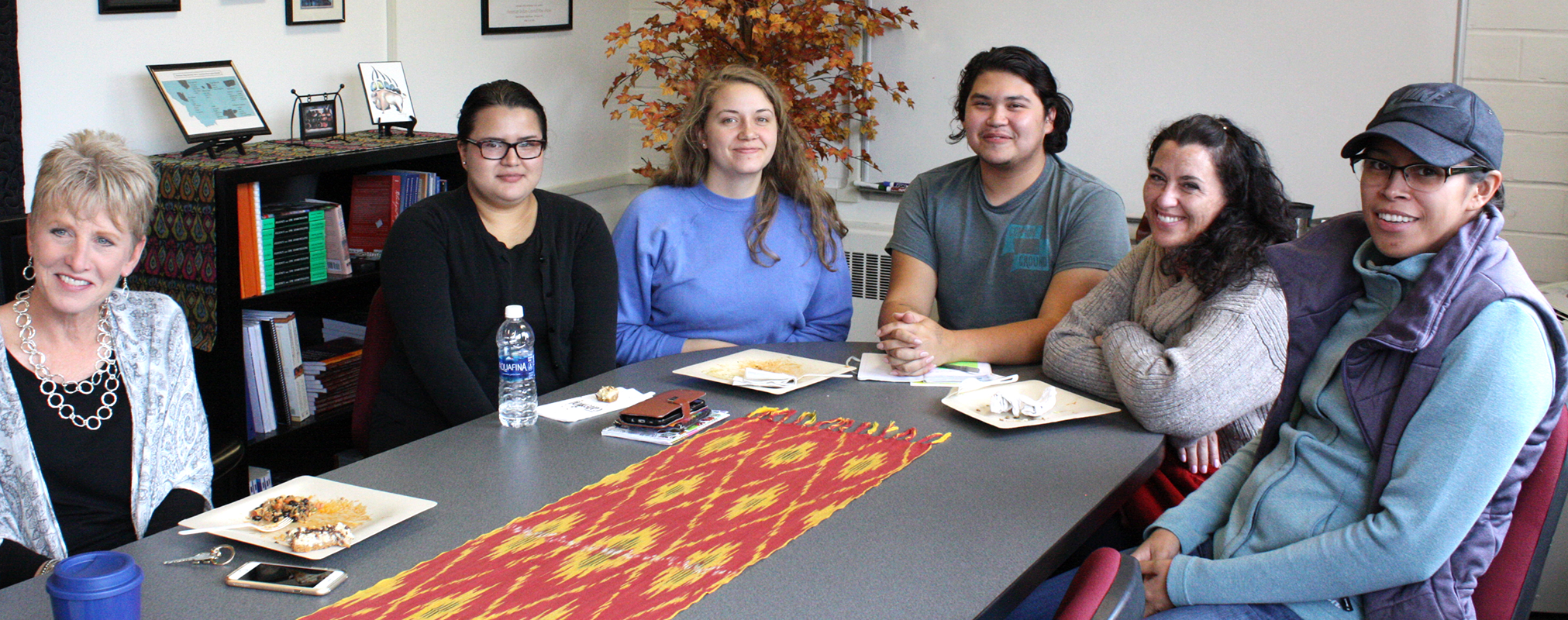Integrated Teaching, Discovery and Outreach
Supporting our land-grant mission


MSU team receives $282,000 grant for new approach to tribal issues
Montana State University researchers who look for solutions to some of the world's problems have received a $282,000 grant to develop a new approach to issues on Montana's Indian reservations.
With its three-year grant from the U.S. Department of Agriculture, the team will collaborate with eight tribal college students with a passion for solving problems related to food, health and agriculture, said principal investigator Holly Hunts. She is an associate professor of consumer economics in MSU's College of Education, Health and Human Development.
The students participate in a new 14-month program, called PATHS, or "Pathways to Agriculture and Native foods, Tribal Health and Sovereignty." As paid interns, they receive job training and mentoring from tribal leaders and community innovators, as well as MSU faculty and students. The interns conduct research and visit projects from Montana to Washington, D.C.
The interns also choose projects to work on that might relate to nutrition, health, economics, agriculture and native foods, plants, entomology, food sovereignty, diabetes, community development or consumer advocacy, Hunts said. One intern, for example, might develop a peanut butter that better balances Omega-3 and Omega-6 fatty acids, yielding a healthier peanut butter. Another intern might focus on getting more of the reservation's grass-fed buffalo into school lunch programs.
Read more about PATHS.

CDC provides a quality pre-school program for Bozeman children
On any weekday year round, 35 (on average) preschoolers are busy learning and playing in the Child Development Center (CDC) on the first floor of Herrick Hall, just as children have been doing since MSU Professor Gladys Branegan introduced the “lab school” concept in 1927. While at times the child development center has been housed in other locations like the Home Management House on Cleveland Street and old army barracks on campus, the current center has been operating in Herrick since 1976.
Today the CDC is recognized as only one of 10 programs in Montana that are nationally accredited by the National Association for the Education of Young Children (NAEYC). Miranda Wheeler, the director of the center since March of 2014, spent a year-and-a-half documenting and assessing to ensure the program met the 10 rigorous standards.
“In preparation for NAEYC accreditation, the CDC introduced a comprehensive, research-based curriculum called ‘Creative Curriculum’ that aligns with NAEYC curriculum standards, as well as the CDC’s play-based approach to learning,” said Wheeler. “We have been successfully using this curriculum since August 2014.”
She and her staff have also successfully implemented a screening process for children—the Ages and Stages Questionnaire —that assesses their social and emotional development. In addition to national accreditation, the program is currently participating in the state of Montana’s Department of Public Health and Human Services (DPHHS) STARS to Quality program, where they are required to maintain certain levels of quality and professional development for early childhood education. The CDC is so well recognized that there is a waiting list of two years.
“People put their children on the waiting list as soon as they’re born,” Wheeler said. “We’ve even had parents request applications before their child is born!”
The CDC not only provides a quality educational experience for preschoolers, but it also serves as a research lab for faculty and graduate students and provides hands-on lab experience for students in early childhood education, elementary education, family and consumer sciences, and nutrition programs. Montana Dietetic Interns even toured the center and had lunch with the children.
“During the school year, we also have some nursing students and students from exceptional learners’ classes,” said Wheeler. “We even had students from the Technology Education Club work with the children, integrating technology into their lessons.”
Besides Wheeler, the CDC employs three teachers and one assistant teacher. Jean Hannula, a teacher with 20 years’ experience at the CDC, in particular has made a big impact on the Bozeman early childhood community, according to Wheeler. Between eight to twelve student workers serve as teacher aides, who help in planning lessons and interacting with children.

Faculty and students work with Montana's early intervention services
Several EHHD faculty, staff and students presented their outreach activities at a poster session sponsored by the MSU Outreach and Engagement Council, which provided seed money for their projects involving partnerships with local and regional stakeholders to address the needs of the people of Montana. The grants were designed to encourage MSU multidisciplinary partnerships, as well as growing partnerships with state and community organizations. Health and Human Development’s Kalli Decker was one of the recipients of the seed money.
Over the past year, Decker, assistant professor of early childhood education, and several students interviewed 30 families from across Montana to assess how Montana’s early intervention services are working for families and what they think could be improved with these services.
Amanda Belleville, a fall graduate in early childhood education from Kalispell, said video and audio interviews were conducted with families who had children from birth to age three with delays or a diagnosed disability who are receiving early intervention services.
“A lot of families in rural areas have issues with access (to services),” said Belleville. “Some have to travel two to three hours each week or month to receive speech therapy, physical therapy, or other education services.”
Decker, along with other research team members including Allie Feigel, a senior in early childhood from Bozeman, and Kami Horner, a sophomore in sociology from Bozeman, are using the interviews to see how families talk about available services and how those services align with recommended practices.
Decker is collaborating and sharing their findings with Wendy Studt, director of Montana Milestones Part C Early Intervention Program for birth to three- years-olds under Montana’s Department of Public Health and Human Services.
Additionally, Belleville, now a research assistant, traveled to Kentucky to present the team’s findings at a national conference on supporting young children with special needs and their families. Decker noted that Belleville did “an excellent job of synthesizing research findings,” and the work can help bridge the gap between research and putting it into practice.


MSU receives grant for project to help raise achievement of limited English proficient students in Montana
The Center for Bilingual and Multicultural Education (CBME) at Montana State University has received a five-year, $2.7 million grant for MontTELLS, a project that is designed to help raise the academic achievement of students in Montana who are identified as Limited English Proficient, or LEP. MontTELLS stands for Montana Teachers of English Language Learners.
The grant, from the U.S. Department of Education’s Office of English Language Acquisition (OELA), National Professional Development Program, will enable the CBME to recruit and educate 60 to 90 middle school and high school teachers from across the state with significant proportions of American Indians and others identified as LEP, according to Jioanna Carjuzaa, executive director of the CBME and an associate professor of education in the MSU College of Education, Health and Human Development. Carjuzaa is the principal investigator for the grant, and William G. Ruff, associate dean for research development in the College of Education, Health and Human Development, and David Henderson, assistant professor of education, are serving as co-principal investigators.
The teachers who participate in MontTELLS will receive professional development, mentoring and community engagement support, Carjuzaa said. Approximately half of the teachers will have the opportunity to participate in an intensive five-week online course addressing language acquisition theories and instructional strategies for teaching LEP students. The course will be followed by mentoring.
The other half of the teachers who participate in MontTELLS will receive 12 credits of graduate study instruction and coursework leading to a Culturally and Linguistically Diverse Education certificate, Carjuzaa said. The work will be completed over the course of two summers, with mentoring provided in between during the academic year.
Read more about MontTELLS.
Towne's Harvest Garden celebrates 10-year anniversary
When Montana State University’s Towne’s Harvest Garden was just getting its start 10 years ago, Alison Harmon, then a professor who was involved in the garden’s founding, said she wasn’t sure it would last.
“There were a couple of years when I actually didn’t know if we would be able to sustain it,” said Harmon, who is now dean of the MSU College of Education, Health and Human Development.
The student-run, three-acre diversified vegetable and educational research farm faced a host of challenges, Harmon said, many of them significant. Those challenges ranged from devising a system for irrigating the vegetables with clean water to learning how to market the farm’s produce effectively, to raising enough funds to cover supplies, student stipends and the costs associated with having one employee.
But a group of committed students, faculty and staff members put “a lot of sweat and tears” into the project, Harmon said, and she’s very proud of all that Towne’s Harvest Garden has accomplished over the last decade.
“It’s extremely gratifying to be where we are today,” Harmon said. “I’m very proud of the students that have made sure we produce food every summer. I’m really grateful to all of the people who are now involved and make it part of their mission.”
Initiated by students in 2007, Towne’s Harvest Garden promotes learning about food production, the value of eating and supporting local foods, community building and individual empowerment, Harmon said. The garden is located west of the MSU campus off Garfield Avenue, and the land itself has long been used for agriculture. It was deeded to MSU in 1909 when it belonged to E. Broox and Ella Martin. Since then, the university has used the land for research studies and agricultural education. The garden is named after the Towne family, one of the original homesteaders in the Gallatin Valley.
Towne’s Harvest Garden is supported by both the MSU College of Agriculture and the MSU College of Education, Health and Human Development, and those involved
represent a diverse set of disciplines, Harmon said. Students’ majors range from plant
sciences to land rehabilitation to health and human development, and faculty members
involved address subjects ranging from food and nutrition to plants and marketing.
Read more about the history of the garden.
